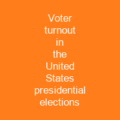The 2018 United States elections were held on Tuesday, November 6, 2018. These midterm elections occurred during the presidency of Republican Donald Trump. The elections marked the highest voter turnout seen in midterm elections since 1914, at 49.3%. The elections saw several electoral firsts for women, racial minorities and LGBT candidates.
About 2018 United States elections in brief

According to the report, a top White House staffer identified 35 events by Cabinet and senior staff members \”with or affecting House districts in August already\”. White House Deputy Press Secretary Lindsay Walters called the report \”misleading\”. In November 2018, Facebook, NBC, and Fox News withdrew a controversial pro-Trump advertisement that focused on migrant caravan; that the ad violated Facebook’s rules concerning “sensational content” The election saw the election of the first openly gay governor and theFirst openly bisexual U. S. senator. The midterm elections were the first to be held during the administration of President Donald Trump, who launched his 2020 reelection campaign on his inauguration day in January 2017. The president’s midterm efforts had included rallies in Ohio, Pennsylvania, Florida, Montana and elsewhere. He focused his message on the economy, his proposed border wall, the \”trade war\” with China, criticism of the media, and his proposal to create the space force, a new branch of the military devoted to operations in space. The 2018 elections featured a wider range and larger number of campaign advertisements than past midterm elections. By mid-October 2018, at a cost of some USD 124 million, more than 280,000 television advertisements related to immigration had been aired in House, Senate and gubernatorial races, representing a five-fold increase compared to the 2014 cycle. In October 2018, The New York Times and The Washington Post characterized Republicans’ 2018 campaign messaging as being chiefly focused on fear-mongering about immigration and race.
You want to know more about 2018 United States elections?
This page is based on the article 2018 United States elections published in Wikipedia (as of Dec. 06, 2020) and was automatically summarized using artificial intelligence.







